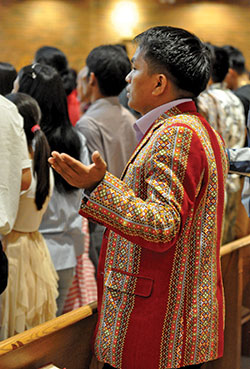Explaining history, dispelling myths of refugees from Myanmar

Paul Hnin, a refugee from the Hakha Chin region of Myanmar, wears a suit coat made with traditional Hakha Chin material as he raises his hands in prayer during a Mass celebrated in his native language by Bishop Lucius Hre Kung, visiting from the Hakha Diocese in Myanmar, at St. Barnabas Church in Indianapolis on Aug. 4. (Photo by Natalie Hoefer)
(Editor’s note: The following is an abridged version of an article originally published in the Feb. 24, 2017, issue of The Criterion. It has also been edited to include recent additional comments.)
By Natalie Hoefer
Myths and misunderstandings about Burmese refugees in Indianapolis abound, says Heidi Smith, director of Indianapolis Catholic Charities’ Refugee and Immigrant Services (RIS).
To provide background and dispel the myths, The Criterion talked with Smith, as well as with refugees and priests from the war-impacted country. Below are their insights and information.
Historical snapshot
-
A civil war in Myanmar (formerly Burma) began in 1948.
-
Current refugees from Myanmar—who are still called “Burmese” despite the country’s official name change in 1989—started arriving in Indianapolis in the late 1990s as victims of attacks carried out by both the government and rebels opposing the government. Attacks were still being carried out as recently as 2017.
- “If the government came into a village, you [had] to do whatever they say. And when the rebels came in, they [said], ‘You are helping the Burmese government.’ That’s why they kill everyone.” —Rita Si Si Lwin, member of St. Pius X Parish in Indianapolis, refugee from Myanmar’s Karen State
- “There was always fighting, murder by the government troops. Some of them, their villages were burned down and they had to flee. Many lived there [in refugee camps in India, Malaysia and Thailand] for more than a decade.” —Father David Bu Nyar, associate pastor of St. Pius and St. Mark the Evangelist parishes in Indianapolis, sent from Myanmar’s Loikaw Diocese to minister to the Burmese of both parishes
- “There are so many refugees left in the camps. They can’t go home to Myanmar. … They need many prayers.” —Paul Hnin, member of St. Barnabas Parish in Indianapolis and a refugee from the Hakha region of Myanmar who lived for seven years in a refugee camp
Tribal ties and language barriers
-
The refugees do not consider themselves “Burmese,” but rather identify with one of the country’s 135 ethnic groups, or tribes.
-
Consequently, there are three distinct refugee communities in Indianapolis: those primarily of the various Karen (or Kayin) State tribes at St. Pius, those predominantly of the Zomi Chin tribe at St. Mark, and those of the Hakha Chin tribe at St. Barnabas.
-
Each tribe speaks a unique dialect. Additionally, the Karenni (or Kayinni) of St. Pius and the Zomi Chin of St. Mark learned to speak the national Burmese language in school, so they are able to communicate and worship in a common language.
-
Because the Hakha Chin live in remote mountain villages, “Many Hakha Chin had no chance to go to school. They only know their local language.” —Bishop Lucius Hre Kung, head of Myanmar’s Hakha Diocese.
Finding a new home—and help
-
Burmese (and all) refugees come to Indianapolis through RIS. The agency represents the archdiocese as a participant organization in a partnership between the federal government and the U.S. Conference of Catholic Bishops’ Migration and Refugee Services.
- “They receive very short-term financial aid that’s meant to cover rent and utilities. They do not receive government money to buy houses and cars as some believe. [Burmese refugees] are very family-oriented and hardworking, so they’re able to save the money they earn very quickly. They start working in the first few months of when they arrive here. They don’t have much control over their lives, so the minute they can make a life of their own and be independent, they run for it. That’s why people see them buying homes and cars so quickly. It’s all with the money they earned themselves.” —Heidi Smith
(For more information on this and other myths about refugees in Indiana, go to www.in.gov/isdh/24670.htm. For more information on RIS and how to volunteer or donate, go to www.archindy.org/cc/refugee or contact Heidi Smith at 317-236-1518, 800-382-9836, ext. 1518, or hsmith@archindy.org.) †
Related story: Chin bishop sees ‘big difference’ in Burmese refugees at St. Barnabas
